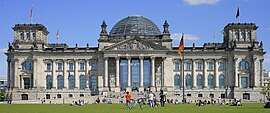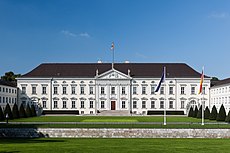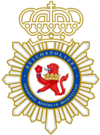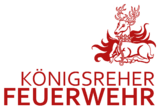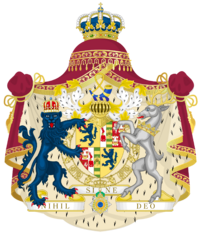Königsreh
This article is incomplete because it is pending further input from participants, or it is a work-in-progress by one author. Please comment on this article's talk page to share your input, comments and questions. Note: To contribute to this article, you may need to seek help from the author(s) of this page. |
Königsreh | |
|---|---|
| Free Capital City of Königsreh Freie Reichshauptstadt Königsreh | |
From top, left to right: Köpenick city skyline, St Lorenz Cathedral in front of the Königsreh Signal Tower, Victory Gate, Academy of the Arts on Palace Island, Köpenick Palace, Kürassierenmarkt with the Konzerthaus, flanked by the Mascyllary Church (left) and the Cuthish Church (right), Reichsrat Building | |
| Country | |
| State | Königsreh |
| Founded | 21 March 1811 |
| Government | |
| • Mayor | Paul Friedrich Choldwig (RU) |
| Area | |
| • Capital city and federated state | 928.9 km2 (358.7 sq mi) |
| Elevation | 48 m (85.30 ft) |
| Population (2018) | |
| • Capital city and federated state | 3,231,326 |
| • Density | 3,482/km2 (9,020/sq mi) |
| • Metro | 7,311,177 |
| Demonym(s) | Konigsrehers (Fallish), Königsreher (m), Königsreherin (f) (Hesurian) |
| Time zone | UTC+2 (EST) |
| Postal code | 01 |
| Area code | 536 |
| Vehicle registration | KR |
| Website | koenigsreh.ma |
Königsreh or Konigsreh (Hesurian: [ˈkøːnɪçsˌreh]), officially the Free Capital City of Königsreh (Hesurian: Freie Reichshauptstadt Königsreh), is the capital and second-largest city of Mascylla. It is populated by 3,231,326 (2017) inhabitants, making it one of the most populous cities propers in Berea, and second only to Flussmund in Mascylla. The city and its surrounding adjacent urban agglomeration is one of Mascylla's 18 federated states, and it is surrounded by the states of Eustria–Folnery, Shwesia, Nelgery, and Falia. Together with Flussmund up north it forms the second-most populous metropolitan area in the country, referred to as the statistical Königsreh–Flussmund Greater Metropolitan Area (Metropolregion Königsreh-Flussmund), closely behind the Elbgau–Blaugold region.
In the aftermath of the establishment of the Mascyllary Kingdom, Königsreh was developed and constructed as a planned city by Ernst Ignatius von Gneisloe. In 1811, the arrival of Lucas I and his court to the Royal Palace (Königliches Schloss) as well as the first session of the Reichssenat officially inaugurated Königsreh as the capital city of Mascylla, replacing Lancaide. Königsreh quickly evolved into a large metropolitan area during the Gründerjahre and Neuzeit, becoming the third-largest city in the world by the 1920s. The city served as the historical seat of government of the Mascyllary Kingdom (1793–1923), the short-lived May Republic (1923–1924), and the Crowned Republic of Mascylla (1924–present).
The city lies on the banks of the River Blaugold, which flows through the city centre towards the Mascian Bight of the North Sea. Various smaller lagoons and lakes dominate Königsreh's topographical makeup in the western and southern boroughs, and an abundance of greenery, forests, parks, rivers, canals, and gardens largely shape the cityscape. Due to its location in the Great Mascyllary Plain and Königsreh Bay, Königsreh receives a temperate and seasonal climate.
A global city and hub according to the Newcott World Cities Index, Königsreh is often referred to as one of the world capitals of culture, finance, and media, and exerts a significant influence upon commerce, entertainment, art, fashion, sports, technology and research, education, politics, and tourism. Home to the headquarters of the Assembly of Nations, Königsreh is an important center for international diplomacy. The service-based and highly entrepeneurial economy of Königsreh is populated by high-tech and IT firms, biomedical engineering companies and the healthcare industry, automotive manufacturing, cleantech and other startups. The city of high standard of living is well known for its multiculturalism, nightlife, contemporary lifestyle, and high social attractiveness, as is the internationally well-known Landherrenallee.
Major landmarks of Königsreh are the Victory Gate, the Reichsrat building, the scenic Straße der Krone, the Assembly of Nations headquarters, the Königsreh Column of the Great War, Lobrecht Palace, Köpenick Palace, St Lawrence Cathedral, and the Fernsehturm Königsreh. Its zoological institutes, encompassed in the Zoologischer Park, is the most frequently visited zoo in Berea. Ellingerode was the world's first large-scale film studio complex and continues to be a global center of the television and motion picture industry, hosting award shows of international acclaim such as the annual Mastery Awards. The historical city centre is a popular tourist destination, with renowned universities, orchestras, museums, and galleries; these include the Hährnig University, the Technical University, the New University, the University of the Arts, the TSEM, the Palace Island, the National Gallery, the Pergament Museum, the Old Museum, the New Museum, the Academy of the Arts, the National History Museum, the Royal Library and Opera, and the Königsreh Philharmonic.
History
Prior to construction
Gneisloe plan and construction (1794–1811)
Königsreh is the last major Berean city to have been planned and constructed as a planned city. King Lucas I sought to replace the late medieval Lancaide as his established residence with a new city that was open in layout, flexible for further expansion, and befitting of his new station as Mascyllary King. According to myth, Lucas I was
Aldia and Mascyllary Kingdom (1811–1916)
Interwar period and Greater Königsreh (1916–1924)
Crowned Republic (1924–present)
Geography
Location
Topography
Parks and nature
Climate
City administration
Demographics
Cityscape and architecture
Boroughscape of Köpenick
Main article: Köpenick
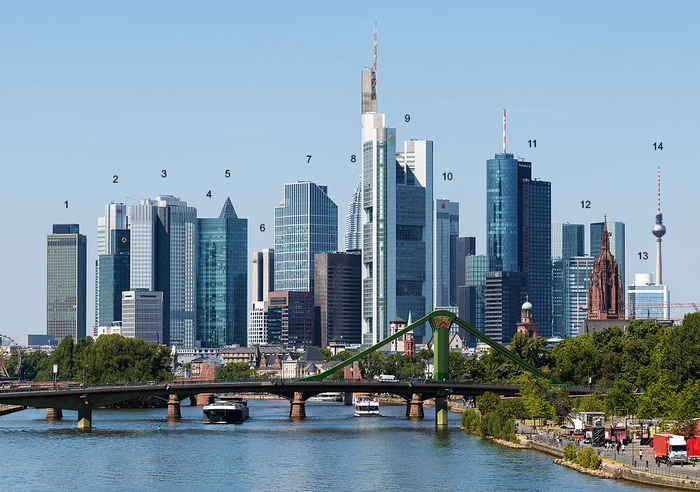
1 EU Steuber Complex · 2 Großklosterstraße 34 · 3 Alestan Center · 4 Lemge Tower · 5 Messalt Tower · 6 Culture Forum · 7 Grunestraße 2 · 8 Headquarters of the Assembly of Nations · 9 Magnall Tower · 10 Triad Tower · 11 Blaugold View · 12 Sindelmähner Gate · 13 New Radio Building · 14 Königsreh Signal Tower
Politics
As the Mascyllary capital

The Reichssenat of the Mascyllary Kingdom decided in 1794, one year after the unification of Mascylla, in the so called "Capital Order" (Hauptstadtbeschluss) that a newly erected city as the capital would house the Reichssenat and the Reichsrat as well as the Government of Mascylla. Therefore, Langquaid was relinquished of the title of capital city and Königsreh determined as the new seat of government.
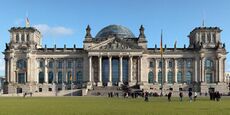

Since 1800 the Monarch maintains his or her primary seat in the Königsreh Palace and Hohenehr Palace. Subsequently, in 1803, most of the government and authorities relocated from Langquaid to Königsreh. The Reichsrat, Reichssenat and Mascyllary government have since then begun operating in the Mascyllary capital. In 1810 the new Kronenrat building was inaugurated and first obtained by Prime Minister Wilhelm von Stenreck. Other government buildings were erected between 1810 and 1813; the latest government agency to relocate to Königsreh was the DSA after its new headquarters was erected in 2015. All 16 ministries and agencies of the Kronenrat have their mean seat in Königsreh, but also operate secondary seats in Langquaid. Most of its government official releases (Reichsgesetzschrift) and statements (Reichsankündigungen) are still being released in the other city to this day, and no high court is located in Königsreh, but in Augusthal, Langquaid and Lehpold.
Most sovereign states have their embassy to Mascylla in Königsreh, while the 21 federal states and free cities have additional representative offices. International organisations such as the Telmerian Union, UPESCH and BDTA also maintain offices. A large number of diplomatic representations are located in the Diplomatenviertel and on the Lorenzinsel in the city centre.
As the seat of government of the largest economy in Berea, Königsreh is one of the influential and sought after centres of Berean politics. Party headquarters, labour and trade unions, foundations, organisations and lobby representations of companies are all maintaining seats and offices in the city. State visits and receptions on every political level as well as important celebrations dominate the political schedule of Königsreh.
As the state of the Kronlande
Königsreh as an Imperial Free City (Freie Reichsstadt) is an autonomous federal state in Mascylla, the Kronlande. The Kronlande solely encompasses the City of Königsreh (Stadt Königsreh) per definition. The state itself is divided into seventeen boroughs, while each of them are further subdivided into neighbourhoods.
The parliament of the state that exercises legislative power is the House of Deputies of Königsreh (Abgeordnetenhaus von Königsreh), in which deputies of the SDP, RU, MDP, NDU, Independent Voters and VP are seated. As of 2022, the government is led by the SDP, in coalition with the MDP and RU. The Senate of Königsreh (Königsreher Senat), consisting of the Mayor (Bürgermeister) and ten additional senators, makes up the government of the state (Landesregierung). While the Mayor is responsible for political affairs of the state, the ceremonial head of state is the currently reigning monarch since 1803. The senator administrations have similar tasks as its counterparts in the Mascyllary government.
Subdivisions
City services
The state of the Kronlande as well as every other state and free state in Mascylla is served by the Imperial Police (Reichspolizei). It is subdivided into eight local directives, as well as the Kronlande Criminal Agency (Kriminalamt Kronlande). The police service employs around 21,500 people, 17,900 of which officers and the remaining 3,600 support staff and administration, making it the largest localized police service in Mascylla.
The Königsreh Fire Department (Königsreher Feuerwehr), being founded in 1870, is the oldest continuous fire department of Mascylla. With its 3,980 employers and up to 31 fire stations it is also the biggest urban fire department in the country. It is supported by 50 voluntary fire brigades with approximately 1,220 active unsalaried members and partly made up of the Städtisches Hilfswerk (SHW) in Marienfelde.
Coat of arms and flag
The coat of arms of Königsreh depicts a sitting, white deer with a golden antler and golden hooves in a golden shield. Sometimes the crown of the Mascyllary monarchs is depicted to crown the coat of arms to symbolize the unique status of the city. The deer is the namesake of the city and is derived from the heraldry of the House of Ahnern and therefore the first king who founded the city, Lukas I of Mascylla. The colours of the shield, green and yellow, reflect the city's abundance in nature and its royal status, respectively.
The state flag of Königsreh is composed of two horizontal stripes of green above and yellow below. It is a continued design with few stilistic differences since it was first flown in 1862. Previously, the flag featured the coat of arms in between the two stripes on a white background, but it was redacted since it appeared too similar with the flag of Eustria and was too complex to identify from far away.
The uniformed statute of waving flags (in front of state authority buildings):
Flag of the Telmerian Union
Flag of the Berean Defence Treaty Association (for specific events and buildings)
Urban partnerships
The city of Königsreh maintains city partnerships with ![]() Lilienburg City, Lilienburg (1947),
Lilienburg City, Lilienburg (1947), ![]() Tinz am Sigmund, Temaria (1966),
Tinz am Sigmund, Temaria (1966), ![]() Aniarro, Lavaria (1968),
Aniarro, Lavaria (1968), ![]() Kristianshavn, Norden (1971),
Kristianshavn, Norden (1971), ![]() Ulich, Dulebia (1985),
Ulich, Dulebia (1985), ![]() Toulogne, Sarrac (1988), and
Toulogne, Sarrac (1988), and Sydenham, Falland (1988).
Infrastructure
Public transport
Further reading: Königsreh U-Bahn
Motor traffic
Air traffic
Further reading: Königsreh–Albert Polschnitz Airport






